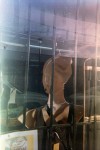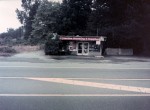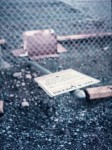Jul
22
2023
Apparently I didn’t think enough of this camera before I developed the film to bother recording any of its details and my opinion didn’t improve after. My best guess is this was a thrift store disposable camera find that spent years in someone’s closet. With the images that follow keep in mind these are the good ones.
no comments | posted in Photography, Processing
Jun
22
2019

Back in 2011 Kodak updated Portra 160 using the technologies from their motion picture Vision films. While Portra 160 does have a finer grain structure than Portra 400 they have it rated for sharpness even a tiny amount bellow Portra800. Its grain though falls between Portra 400 and Ektar 100 which is claimed to be the finest grained colour negative film ever.

Given all this it should perform similar to Portra 400 but with a slightly lower sensitivity and perhaps every so slightly softer which may be why Kodak present it as a film ideal for portraiture.
You can see that 160 and 400 have similarly shaped spectral curves that differ from Ektar 100. The images from Portra 160 & 400 emulsions properly exposed should therefore give similar results which is what I have found.

This is one of the reasons I gravitate towards Portra 400 rather than 160 I rarely find myself in a situation where there is just too much light to shoot 400. And given the abilities of these films to handle over exposure of several stops it just isn’t a problem shooting 400 speed film. Also with a hybrid film to digital workflow there is always the ability to make some adjustments. So while I do use Portra 160 from time to time as seen in the images below I prefer Portra 400 for its versatility.
You can find more info around Kodak Alaris films here
Kodak Alaris
1 comment | posted in Photography, Processing
Apr
27
2019

I bought a few rolls of what Photo Warehouse calls “Ultrafine Colouruption” Now I’m not complaining because I did expect strange results but the name is a bit of a misnomer as it’s more of a “Mute-elation”. Inspecting the film edge it becomes clear that this film is actually ORWO NC3 the “NC” apparently stands for Negative Colour, I’m not sure what the 3 means yet but if its a quality scale that goes to ten I think 3 is being generous. This film apparently hasn’t been manufactured for years and was originally intended as movie film and likely came in canister with a label much like this.

Thanks for the use of the image The Vintage Europe
The film also apparently has a different developing process than C41. Without it can you really call this a colour film? Many of the pictures seem to be bereft of any colour other than a cyan cast while some others have a few selective colours that survive in particular green. Overall I would describe the colours as muddy. The closest comparison I can think of is the look of faded slides like Anscochrome Any way you look at it this is a strange film that behaves like nothing else I know. Ultrafine has it listed as 25 ISO but I suspect you could use a lower setting yet.
I’m also not saying its this films fault (It’s not) but my Konica Auto S3 died half way through the roll. Repairing it is another post though. Konica Auto S3 Battery Holder repair
no comments | posted in Photography, Processing
Mar
30
2019

Just some random pictures from a roll of Cinestill 800 T I ran through my Pentax MZ6. Some other posts with Cinestill 800 can be seen here Seattle, Canon A1 , 2015, Nocturnes, Niagara, Industrial, Gatineau
no comments | posted in Cameras, Photography, Processing
Feb
24
2019

I was half way through this roll of Ultrafine Colouruption (ORWO NC-3) in my Konica Auto S3 when it stopped working. So I thought I would finish it in this camera with the idea that if it ended up being a grainy film that it would be accentuated by the half frame capture. However despite the strange colours the film is not particularly grainy. Nothing like the graininess of Adox Color Implosion although the colour shifts are even more extreme with this emulsion.
Here is a comparison shot taken with my Pentax Q7 digital camera and the Fuji Drive with Colouruption.


Now about the Fuji Drive. It has a 28mm f2.8 5 element lens which is surprisingly good but the cameras unique feature has to be that it uses a clockwork mechanism to advance the film. This is of course where it gets the name “Drive” from. The camera has a selenium meter that can be used for fully automatic exposure but you can also manually select shutter and aperture for more control. Also the meter system was made at a time when 100 ASA film was considered fast so it only goes to a maximum of 200 ASA. I’m also not really a fan of zone focus with most cameras so that’s a strike against it but if you pay attention to focus and set exposure manually you have a nice photography tool that is fun to use.
Another camera in my collection that has a clockwork film advance is the Ricoh Auto Shot.
no comments | posted in Cameras, Photography, Processing
Feb
17
2019

Some films age gracefully, some just fade away but Konica 400 VX does neither it turns everything magenta in a fit of rage. I know what your thinking ‘why don’t you just colour correct it?’ Well there is no colour correction on earth that can handle what ever this is. Yes I could adjust it but that would just give me a new set of weird colours.

I think I owe an apology and a roll of some decent film to my Yashica T3 now like this Agfa Vista 200 I used in it last time. Yashica T3 With Agfa Vista 200
no comments | posted in Photography, Processing
May
19
2018

I had a roll of Agfa Precisa 100 which is a slide film meant for E6 development however I opted to develop it in C41 color negative chemistry. This is commonly referred to with the self explaining name ‘cross processing’ As with many things ‘film’ I like the somewhat random nature of the results. Some images turned out with very little to tell them apart from an image processed normally to other images having severe colour shifts. Part way through the roll I also opened up the back of the camera for a little bit of a light leak across some frames. Doing this of course you loose some images and you risk ‘damaging’ what might have otherwise been a good image. On the flip side you can get some interestingly effected images that would be hard to achieve any other way. You might be able to get a faux light leak result with some photo manipulation but someone needs to create the baseline of what would happen in the real world.
The shift in colour was quite unpredictable as can be seen from these two images of the same sign. The one on the left was taken shooting into the light and the one on the right was taken away from the light. The shift towards green isn’t equal across the entire image but happens primarily in the blues of the sky. That image is as scanned with no effort made to hide the effect through adjustments.

I’m happy with the results and continue to be enamored with the Olympus 35SP which has risen to be my favorite rangefinder camera. More about this camera here Olympus 35 SP
While many people think of a 50mm lens on 35mm film as being the normal focal length that approximates what the human eye would see the actual diagonal of a 35mm film frame is around 43mm which means that the 42mm lens on the 35SP is much closer to the ideal normal lens than 50mm is. One more reason the Olympus 35 SP is an awesome camera.
no comments | posted in Photography, Processing
Apr
28
2018

While I enjoy using rangefinder and point and shoot cameras there is no doubt for versatility its the SLR that wins. That’s why when I have the space and can spare the weight I like to bring along an SLR on trips. In this case the camera was the Pentax MZ6 one of the last film SLR’s produced by Pentax and full of all the features you need in a small light package.
I haven’t shot much of the Kodak Portra 160 mostly because it seems like an odd sensitivity. It has a Print grain index of 79 at a magnification ratio of 17.9 while Ektar is 66 and Portra 400 is 89. With only a marginal improvement in granularity over the Portra 400 it makes choosing it more about needing the slower ISO at which point the Ektar comes into play. Then the choice is more between their colour rendition the more punchy saturated Ektar vs the more muted skin tone friendly Portra.
no comments | posted in Photography, Processing, Uncategorized
Apr
22
2018

Different films often say ‘load film in subdued light’ but few of them require it to the degree that Rollei CN200 does. Each roll that I have shot so far has had ‘unwanted’ light strike the film while it is inside the canister. I placed unwanted in quotes because I could have been more careful to prevent it if it really mattered to me more. I like the randomness that can occur. What appears to happen is that the tang of the film leader sticking out of the canister works like a light pipe allowing the film to transfer light from outside to inside. The most clear evidence of this is the way that the first 12″ or so of the film is exposed to sunlight in a diminishing fashion.

The reason that this may occur with CN200 is it is an unmasked film. Unlike most negative colour films it does not have the same orange brown color mask but its base is clear as you would see with slide film. An interesting side effect of the lack of the normal C41 mask is that the film can be optically printed with Black and White paper the same as normal Black and White film. A quick check on the Internet as of January 2018 and this film is not available through any retailers I can locate which is a shame. Posts that actually talk about the Yashica Electro GX can be found by a search of my blog here “Yashica GX”
no comments | posted in Photography, Processing
Feb
11
2018

I loaded my trusty Pentax MZ6 with some Cinestill 800t film which I really like the look of particularly for the way it creates halos around bright lights against dark backgrounds. You can see my discussion around why that occurs here “Niagara at night” Coupling the fast film with some equally fast lenses such as the Vivitar 28mm f2.0 Close Focus allows me to forgo a tripod even when walking around at night.
1 comment | posted in Cameras, Photography, Processing








































































































































































































